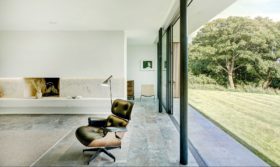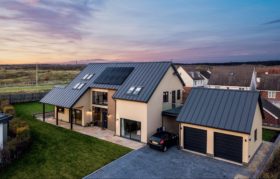
Learn from the experts with our online training course!
Use the code BUILD for 20% off
Learn from the experts with our online training course!
Use the code BUILD for 20% offAlso in this series:
A simple and cost-effective configuration, casement windows are basically formed of a piece of framed glass that opens on a hinge.
Offering one of the most cost-effective solutions thanks to the simplicity of their engineering, they’re used across a huge range of building styles.
You are likely to find leaded versions in country cottages and steel options in early 20th century homes, for instance – the style remains hugely popular for modern builds, too.
They can be specified without glazing bars to maximise views, while a French casement window has no centre post, offering an unobstructed outlook when open.
Casements can be designed flush with the exterior of the dwelling, or rebated to a greater or lesser degree for better protection from the elements. Deeper rebates can also help add visual interest to a property, as the change in depth helps break up space. Using a different material for the cills can also add character.
With frames available in a range of materials, standard, off-the-shelf PVCu options can be found on the lower end of the price range. Engineered softwood is next on the scale, followed by aluminium and hardwood – although these materials offer more durability and stability.
Ian Hodgkin from Scotts of Thrapston explains the benefits of installing casement windows
These windows actually offer excellent security and insulation, as well as the versatility of fitting with an array of architectural styles, from period properties to modern dwellings. Flush casements are often found in neo-Georgian homes, while rebated versions are used across a variety of builds, either in timber, PVCu, aluminium or composite frames.
They can be incorporated into both renovations and new builds and generally come at a lower cost than sliding sashes or other modern configurations.
Source it: Find windows and glazing in the Build It Directory
Nowadays, thanks to the high performance products available, it comes down to personal choice. Flush casements lend themselves to older, pre-war properties as they are more of a traditional style window, supplied in imperial sizes, and sit flat to the frame.
In contrast, rebated windows sit proud of the frame and are generally referred to as stormproof windows. They offer an additional layer of protection against the elements such as drafts and water ingress. These have become and are the standard design for casements since the 1960s.
Not necessarily; there’s a range of options available. For instance, top hung models are a great choice – especially for upper floors where you’d generally find the bedrooms. These windows tend to be smaller openings that offer ventilation without compromising a property’s security.
Hopper hung, on the other hand, swings inwards and is often specified where there is restriction on the opening size, such as minimal wall space or safety concerns. You are more likely to find this type of casement design in bathrooms or basements.
Top image: For this bathroom, the aluminium casement windows from Express Bi-folding Doors were installed for ease of upkeep. The 1,685mm x 1,350mm unit cost £900 plus VAT installed

